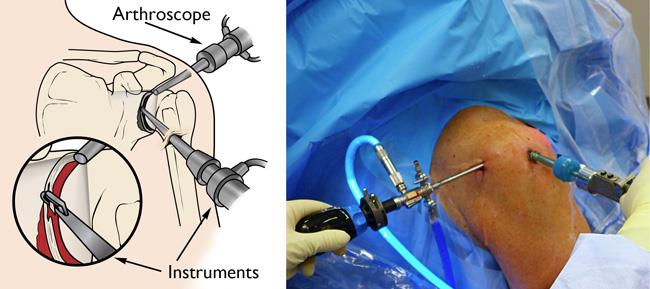SHOULDER
Shoulder Arthroscopy
Shoulder arthroscopy is a form of keyhole surgery that involves inserting a small telescope (arthroscope) into the shoulder to help diagnose and/or treat common knee injuries.
The benefits of arthroscopy include small incisions, minimal scarring, fast healing and rapid recovery. Common arthroscopic procedures include:
- Rotator cuff repair
- Removal or repair of labrum
- Repair of ligaments
- Removal of inflamed tissues or loose cartilage
- Repair of recurrent shoulder dislocation

Procedure
Arthroscopy is usually done through small punctures in your shoulder. Fluid may be injected into the shoulder to inflate the joint making it easier to see all the structures through the arthroscope. Images from the arthroscope are projected on the video screen showing the inside of your shoulder and any damage. If a diagnosis is made and treatment is required, Dr du Sart can insert tiny instruments through the other small incisions. Specialised instruments are used for tasks like shaving, cutting, grasping, suture passing, and knot tying. In many cases, special devices are used to anchor stitches into bone.
After Your Operation
Pain Management
During your inpatient stay you will be given pain relief and either medication or prescriptions to go home to keep pain within comfort. Usually patients will initially require regular pain relief consisting of paracetamol and anti-inflammatories if indicated. Stronger medications may be given and helpful in early stages however are phased out as comfort levels increase. Regular ice packs on the shoulder for approximately 20 minutes, three to four times a day can help reduce swelling and pain.
Return to Work and Sport
Return to work will vary on the nature of your work and what was done at surgery. In general, you should plan to have approximately two weeks off work to allow adequate time for your shoulder to heal while your arm is in a sling. You may be able to return to light duties after two weeks, but if your work is physically active and involves lifting, pushing or pulling, it may take up to six to twelve weeks to return. Returning to sport is dependent on the activity and extent of surgery. Dr du Sart will discuss your return to activity at your post-op check.
It is important to follow the physical therapy exercises you are provided to increase shoulder mobility and strength.
Driving
Times to return to driving will vary. However, in general, plan to avoid driving for approximately six weeks and until your sling is removed. If you have concerns, you can discuss this with Dr du Sart.

© All rights reserved
For all appointments and enquiries please contact us on:
Phone: 08 9779 9767
Email: admin@ryandusart.com.au
Address: 6 Higgins St, South Bunbury, 6230
